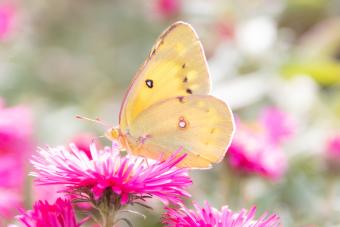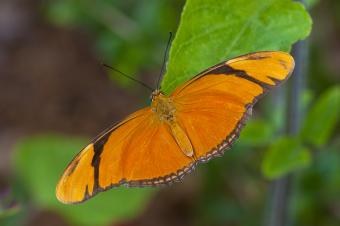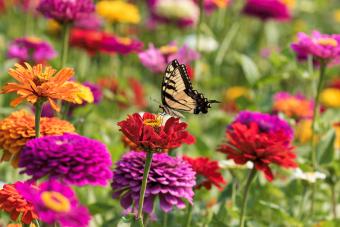
I love nothing more on a sunny afternoon than sitting on my patio, sipping on a cool drink, and butterfly spotting. I live in the Pacific Northwest, so it's usually May by the time the butterflies get to me, but I'm always impressed with their speed, beauty, and ability to fly in a straight line in windy weather in spite of having large, sail-like wings.
For years, "Look - a butterfly" is as far as I was able to go. Then, after a delightful visit to a butterfly garden in Canada where I saw a variety of butterflies I'd never seen before, I felt inspired to learn exactly what types I was seeing and where they were from.
Throughout North America, we may spot different types of butterflies at different times (there are about 750 species that frequent our beautiful continent), but the activity is always time well-spent. Why not head out to your yard and see which of these beauties you can spot.
Monarch

Nearly everyone knows the regal Monarch butterfly. These royal butterflies migrate between 1,200 and 2,800 miles every year between Central Mexico and Canada. Monarch butterflies live four to five weeks, so a single migration may involve many generations. Monarchs have a wingspan of about 4 inches and are orange and black with small white spots.
Swallowtail

There are about 550 species of swallowtail butterflies, although you won't spot all of them in North America. The eastern tiger swallowtail is well known in the United States, and the giant swallowtail is the largest swallowtail in North America with a wingspan that can spread over 6 inches. Swallowtails are named for the "tails" that extend from the back of their wings.
Sulphur Butterfly

Once you've spotted a bright yellow sulphur butterfly, there's no question how it got its name. You'll find these butterflies in the mainland United States, but they've been spotted in southern Canada, too. There are several different varieties of sulphur butterflies.
On a drive along the Texas-New Mexico border last year, my husband and I drove through miles and miles of fields with millions of tiny sulphur butterflies. If you want to see them, I'm going to suggest you go there.
Blue Morpho

Blue morpho butterflies are quite large with a six-inch wingspan. While they're abundant in the rainforests of Central and South America, they are also found in Mexico and in the mid-Atlantic region of the US.
These giant, vividly colored butterflies fly surprisingly quickly - and with a lot of purpose. They're so large and fast that when you spot one in flight, you might at first think it's a bird.
American Copper

These small, copper-colored butterflies with black markings fly fairly low to the ground. They have a small wingspan of about one inch. You'll find them in the summer in North America, Asia, Europe, and North Africa. They fly quickly, but not much higher than two feet above the ground. So, if you spot a low-flying, tiny, orangeish butterfly, it could just be an American copper.
Common Buckeye

These brown butterflies have round markings called eyespots. In the US, you're more likely to spot them in the South, although they do migrate north and have been spotted as far as southern Canada. They are moderately sized with a wingspan of about 2.5 inches.
Eastern-Tailed Blue Butterfly

These small dusty blue butterflies have a wingspan of less than an inch. In North America, they're most common east of the Rockies and in Texas, although smaller populations can be found in the Western states and even in Southern Canada. They are also common in Mexico.
Julia Longwing

The Julia longwing butterfly can be identified by its aerodynamic wide wingspan and bright orange wings with a black racing stripe. You'll find these butterflies in the southern states including Texas, Florida, Alabama, Georgia, Louisiana, and South Carolina. Interestingly, they've also been spotted in Montana, but not in the neighboring states.
Lorquin's Admiral

These orange, black, and white butterflies are mid-sized with a wingspan of about two inches. You'll find them in Mexico and in the Western United States, as well as in British Columbia and Saskatchewan.
The butterfly is named for Pierre Joseph Michel Lorquin. Who's that, you ask? He was a French entomologist (a bug guy) who followed his gold fever to California during the Gold Rush.
Malachite Butterfly

If you live in Texas, Florida, or Mexico, you've probably spotted malachite butterflies from time to time. These tropical butterflies are named for the mineral of the same color, and they're easily recognizable for their vivid green and black markings that give them an almost stained glass appearance. They have a 3-inch wingspan.
Mourning Cloak Butterfly

These richly colored butterflies can be found all throughout Mexico, the United States, and Canada. In the UK, they're called the Camberwell beauty, so you'll find them there, too. As you might imagine, they're named for their dark wing coloration and pattern, which resembles a cloak worn for mourning. Their wingspan is around 3 inches, and they have gorgeously colored markings of deep blue, red, yellow, white, and black.
Red Admiral

With a wingspan of around 2 inches and vivid reddish-orange markings, these pretty black fliers are spotted all throughout North America. While they fly very quickly, they are also fairly erratic in their flight path. Red admirals are people-friendly butterflies, so don't be surprised if one comes and lands on you.
Coral Hairstreak

These tiny butterflies only have a wingspan of about one inch wide. They are dust colored with reddish-orange markings along the edges of their wings. You're most likely to spot them throughout the US and Canada, although they aren't usually found in Florida or Louisiana. They loves shrubbery and pastures, so if you've got some of those around, you're more likely to spot them.
Great Spangled Fritillary

You'll spot the great spangled fritillary throughout most of the United States and Canada - although it's unlikely you'll see one in Texas or Florida. This yellow and black butterfly may have some regional color variations, with the yellow appearing darker yellow or even a rusty orange that you'll often see in the Western states and provinces. Thes great spangled fritillary is a medium-sized butterfly with a 3-inch wingspan.
Sign up for our newsletter featuring all the latest stories and products we love.
Northern Checkerspot

The unique checkerboard pattern on its wings makes the northern checkerspot butterfly pretty easy to recognize. You'll find this small butterfly (it has a wingspan of about 1.5 inches) west of the Rockies in the United States and Canada, particularly the Pacific Northwest.
Zebra Longwing

No - you're not in the Serengeti. If you spot one of these zebra-striped beauties in North America, chances are you're in one of the warm-weather Southern states, from California all the way to Florida. They're also common in Mexico. The long wings span about four inches and may have white or yellow stripes.
Eastern Comma Butterfly

Don't you love it when a butterfly's name tells you exactly where you'll find it? These medium-sized butterflies have brown and white delicately scalloped wings and a green body. You'll find them mostly east of the Rocky Mountains in the US and Canada, as well as throughout Mexico.
Milbert's Tortoiseshell Butterfly

What is tortoiseshell colored, about 2 inches wide, loves nettles, and lives mostly in the Northern United States and Canada? That's right - it's the Milbert's tortoiseshell butterfly. The caterpillars feed together in webs in nettles, but once the butterflies emerge, they head to your garden to enjoy goodies like lilacs and goldenrod.
Queen Butterfly

If you live in the Southern US or Mexico, there's a good chance you've spotted one of these beauties and mistaken it for a monarch. Their coloring is the same, but queen butterflies are slightly smaller (their wingspan is about 3 inches), and they tend to have more small black spots along the black borders of their wings. The black ribbing along the wings is also less pronounced in queens, and, if you want to get really up close and personal, they have three sets of tentacles instead of the two that the monarch does.
Which North American Butterflies Can You Spot?

With hundreds of species of butterflies, moths, and skippers in North America, spring, summer, and early fall are prime time for viewing these fluttering beauties. If you're just not getting your fill of butterfly beauty, consider planting flowers to attract butterflies, and soon your garden will be aflutter with these pretty pollinators.







